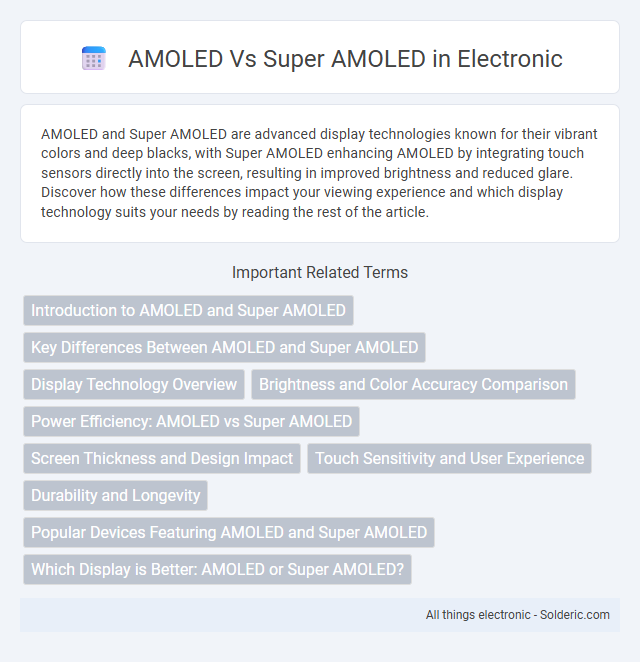AMOLED and Super AMOLED are advanced display technologies known for their vibrant colors and deep blacks, with Super AMOLED enhancing AMOLED by integrating touch sensors directly into the screen, resulting in improved brightness and reduced glare. Discover how these differences impact your viewing experience and which display technology suits your needs by reading the rest of the article.
Comparison Table
| Feature | AMOLED | Super AMOLED |
|---|---|---|
| Display Technology | Active Matrix Organic Light Emitting Diode | Integrated Touch AMOLED with improved layering |
| Touch Sensor | Layered on top of the display | Integrated into the screen, reducing thickness |
| Brightness | Good, but less visible under direct sunlight | Higher brightness, better outdoor visibility |
| Thickness | Thicker due to separate touch layer | Thinner screen with integrated touch |
| Power Efficiency | Efficient but consumes more power than Super AMOLED | More power-efficient due to fewer layers |
| Color & Contrast | Vivid colors, deep blacks | Improved color accuracy and contrast |
| Cost | Generally less expensive | Typically higher due to advanced tech |
Introduction to AMOLED and Super AMOLED
AMOLED (Active Matrix Organic Light Emitting Diode) technology uses a thin-film transistor (TFT) array to control individual pixel illumination, delivering vibrant colors and deep blacks for superior display quality. Super AMOLED integrates touch sensors directly into the display, reducing thickness and improving sunlight visibility by minimizing reflection. This advancement enhances touch responsiveness and energy efficiency compared to traditional AMOLED screens.
Key Differences Between AMOLED and Super AMOLED
AMOLED displays feature a traditional touch layer positioned above the screen, while Super AMOLED integrates the touch sensor directly into the display, reducing thickness and improving touch responsiveness. Super AMOLED offers better visibility under direct sunlight due to its enhanced pixel arrangement and reduced reflection, resulting in more vivid colors and deeper blacks compared to standard AMOLED. Power consumption is optimized in Super AMOLED screens through improved pixel efficiency and brightness control, extending battery life in smartphones and wearable devices.
Display Technology Overview
AMOLED and Super AMOLED are advanced display technologies commonly used in smartphones and wearable devices, known for their vibrant colors, deep blacks, and energy efficiency. Super AMOLED integrates the touch sensors directly into the screen rather than adding a separate touch layer, resulting in better visibility under sunlight, thinner design, and improved responsiveness compared to traditional AMOLED panels. Choosing a display with Super AMOLED technology enhances your viewing experience by providing brighter images and more accurate color reproduction while maintaining lower power consumption.
Brightness and Color Accuracy Comparison
Super AMOLED displays integrate the touch sensor directly into the screen, resulting in higher brightness levels and enhanced color vibrancy compared to traditional AMOLED panels. You can expect better sunlight legibility and more accurate color reproduction on Super AMOLED, making it ideal for outdoor use and vivid multimedia experiences. This advanced technology reduces screen glare and improves contrast, ensuring sharper images with true-to-life colors.
Power Efficiency: AMOLED vs Super AMOLED
Super AMOLED displays enhance power efficiency compared to traditional AMOLED screens by integrating the touch sensor directly into the display, reducing layers and energy consumption. The improved visibility and reduced reliance on backlighting in Super AMOLED panels also contribute to lower power usage, especially in bright environments. This efficiency makes Super AMOLED technology more suitable for devices prioritizing battery life without compromising display quality.
Screen Thickness and Design Impact
Super AMOLED technology integrates the touch sensors directly into the display rather than layering them on top, resulting in a thinner screen profile compared to traditional AMOLED displays. This design innovation reduces screen thickness, enhancing overall device slimness and improving touch responsiveness. Consequently, Super AMOLED enables sleeker smartphone designs without compromising display quality or durability.
Touch Sensitivity and User Experience
Super AMOLED displays integrate the touch sensor directly into the screen rather than layering it on top, resulting in higher touch sensitivity and faster response times compared to traditional AMOLED panels. This technology reduces screen glare and improves visibility in bright environments, enhancing your overall user experience with smoother interactions and vibrant visuals. As a result, Super AMOLED screens offer more accurate touch recognition and better energy efficiency, making them ideal for smartphones and tablets.
Durability and Longevity
AMOLED and Super AMOLED displays both offer vibrant colors and deep blacks, but Super AMOLED panels are designed with an integrated touch layer that enhances durability by reducing screen thickness and improving resistance to scratches and impacts. The improved energy efficiency of Super AMOLED technology also contributes to longer overall screen lifespan by minimizing pixel degradation over time. Your device equipped with Super AMOLED is more likely to retain display quality and durability through extended usage compared to traditional AMOLED screens.
Popular Devices Featuring AMOLED and Super AMOLED
Popular devices featuring AMOLED displays include Samsung Galaxy S21, OnePlus 9 Pro, and Google Pixel 5, known for their vibrant colors and deep blacks. Super AMOLED screens, commonly found in Samsung Galaxy S22 Ultra, Galaxy Note 20 Ultra, and Galaxy Z Fold 3, integrate touch sensors directly into the display, resulting in thinner panels and improved sunlight visibility. Both AMOLED and Super AMOLED technologies contribute to enhanced battery efficiency and superior image quality in flagship smartphones and high-end wearable devices.
Which Display is Better: AMOLED or Super AMOLED?
Super AMOLED displays integrate touch sensors into the screen itself, offering brighter colors, better sunlight visibility, and improved responsiveness compared to traditional AMOLED panels. Your viewing experience benefits from Super AMOLED's reduced screen glare and enhanced power efficiency, making it the superior choice for smartphones and high-end devices. AMOLED screens still deliver deep blacks and vibrant colors but lack the advanced integration that improves durability and display clarity in Super AMOLED technology.
AMOLED vs Super AMOLED Infographic

 solderic.com
solderic.com